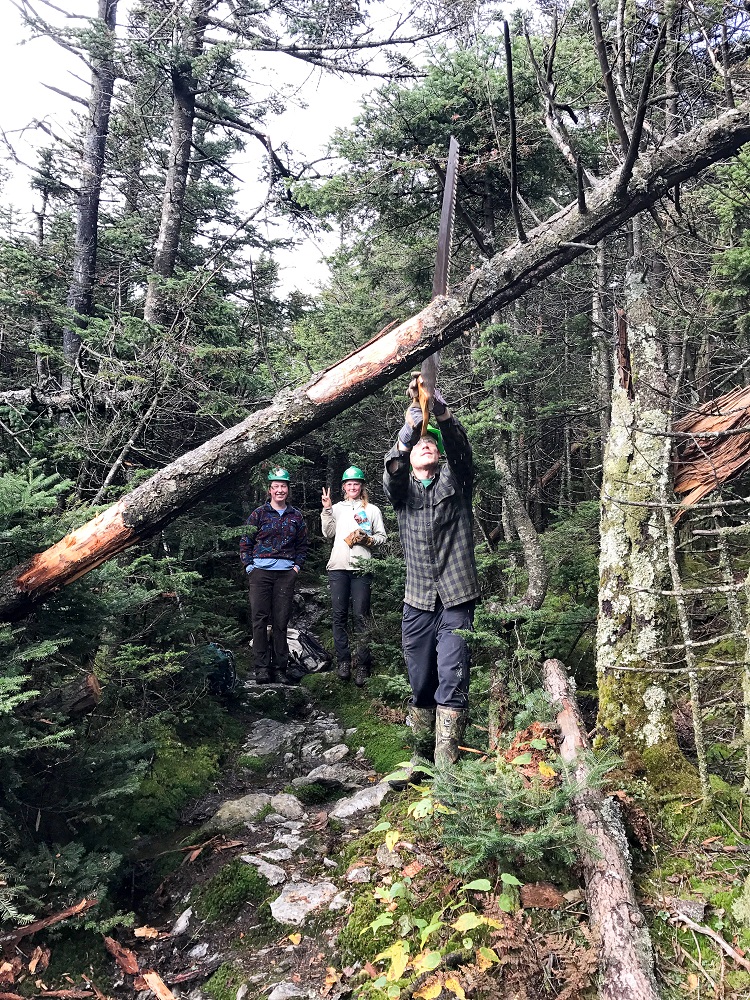This article previously appeared in the Spring 2019 Long Trail News.
I don’t know how much Long Trail pioneers thought about climate or bad storms when designing and building the trail. But after more than a century of trail maintenance and management, the Green Mountain Club is definitely concerned about our changing climate and its effects on the land today.
Climate change is a global problem affected by, and affecting, everyone on the planet. The club’s response is twofold. First, in our daily operations, we seek ways to minimize greenhouse gas emissions.
Second, we have adopted a strategic plan to guide us toward best practices as we design and manage our trails and supporting facilities to withstand increased hiker use and more severe and unpredictable weather. This aspect of preparing for climate change requires special attention.
It is essential to understand the magnitude and speed of climate change to predict how it might affect trails and the landscape. Scientists at the Hubbard Brook Research Station in the White Mountains of New Hampshire have been studying ecosystems for more than 60 years. Here is some of what they have learned:
The Northeast is getting warmer.
- Extreme low temperatures are disappearing. Minimum temperatures have warmed more than maximum temperatures.
- The annual average air temperature is increasing, and winters have warmed more than other seasons.
- There are fewer days of even moderate cold. Compared with 1956, there are now ten fewer days with an average temperature lower than 32 degrees F in a typical winter.
Precipitation has increased.
- Annual precipitation has increased on average 12 inches since 1956, which is substantial—nearly one quarter more rainfall in a year. And the increases aren’t distributed evenly. The largest increase is in summer, the least in winter.
- There are more heavy precipitation and high-water days. Annual days with heavy precipitation (greater than 0.75 inches of water) have increased by 7.5 days on average since 1956.
Snow depth and ice duration have decreased.
- Average snow depth has decreased by about a foot since 1956.
- Mud season is longer, and mud season conditions occur in every month of the year.
- Ponds, lakes, and rivers freeze later and thaw earlier.
Short term variability in weather makes it hard to see long term climate trends. Just recall how different the weather has been at Christmas the past few years: sometimes wintry, other times spring-like—but with no clear recent trend. This is what makes the Hubbard Brook data so useful. Examined over 50 to 60 years, the trends are very clear.

What do these findings mean for the Green Mountain Club?
First, climate change is real and substantial, and likely to accelerate. We must take it into account in trail design and placement, bridges, shelter siting, water control, and invasive species management. For instance, bridges over large rivers, like the Winooski River Footbridge in Bolton, might be built higher (unfortunately making them longer and more expensive), while those over small streams might be designed to float out of the way of floods on tethers and be reset on their piers afterward, saving the cost of new material.
Second, climate affects people as well as the environment, so our approaches to public engagement must also adapt. For example, more people now hike in winter—many without snowshoes—so there is greater need for winter safety education. And the risks have changed, too: ice is more common and harder to travel safely than deep snow.
Our strategy is focused in three key areas:
1) Backcountry caretakers and educators
We must employ enough caretakers to manage increased use and provide public education, in a hiking season that may lengthen. They are the front line for trail and resource management at high use sites. Their presence in the past 50 years has been critical to the club’s success in handling heavy hiker traffic and protecting fragile ecosystems.
2) Technology, science, and best practices
Trails built today will likely be used for the next hundred years, so we have to use the best tools and practices available to ensure our work is durable and functional while not losing elements that make the hiking experience special.
3) Planning and funding
GMC collects information that helps us identify and develop contingency plans for areas on the trail susceptible to extreme weather events. We need to find more reliable revenue sources and establish robust financial reserves so we can respond to unanticipated extreme weather. As the pace and scale of weather events increase, we won’t be able to respond adequately if we can only afford our ordinary operations.
The club needs to remain flexible, strengthen our programs, and use the best available information to make decisions. We must have foresight and act now so trails in Vermont can withstand changes ahead and hikers can continue to enjoy recreating in the Green Mountains.



















Love the article
How about conservation land in towns where citizens are striving for recreation and big trails and thereby loss of trees plants more human and dogs presence and ruining the nature and climate impact
What can we tell the towns to avoid large trails etc
Climate impact is higher there by loss of plants birds animals etc
Any article or data